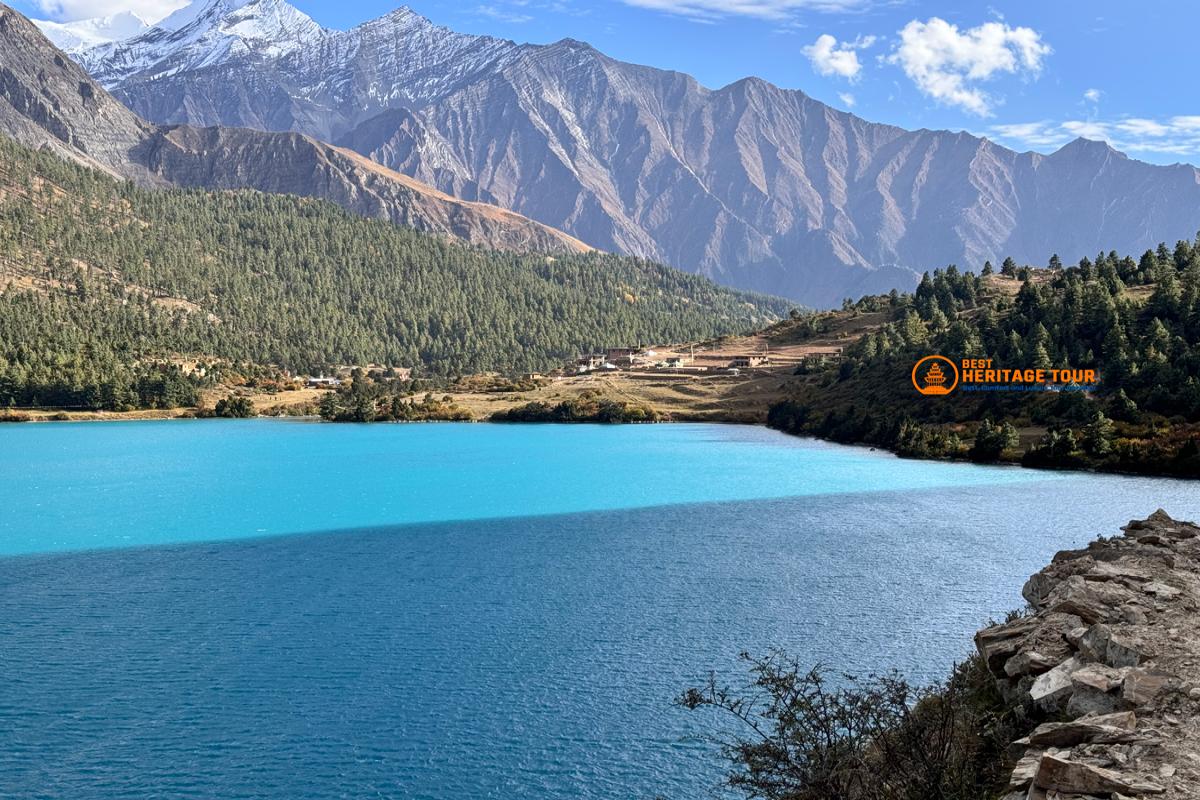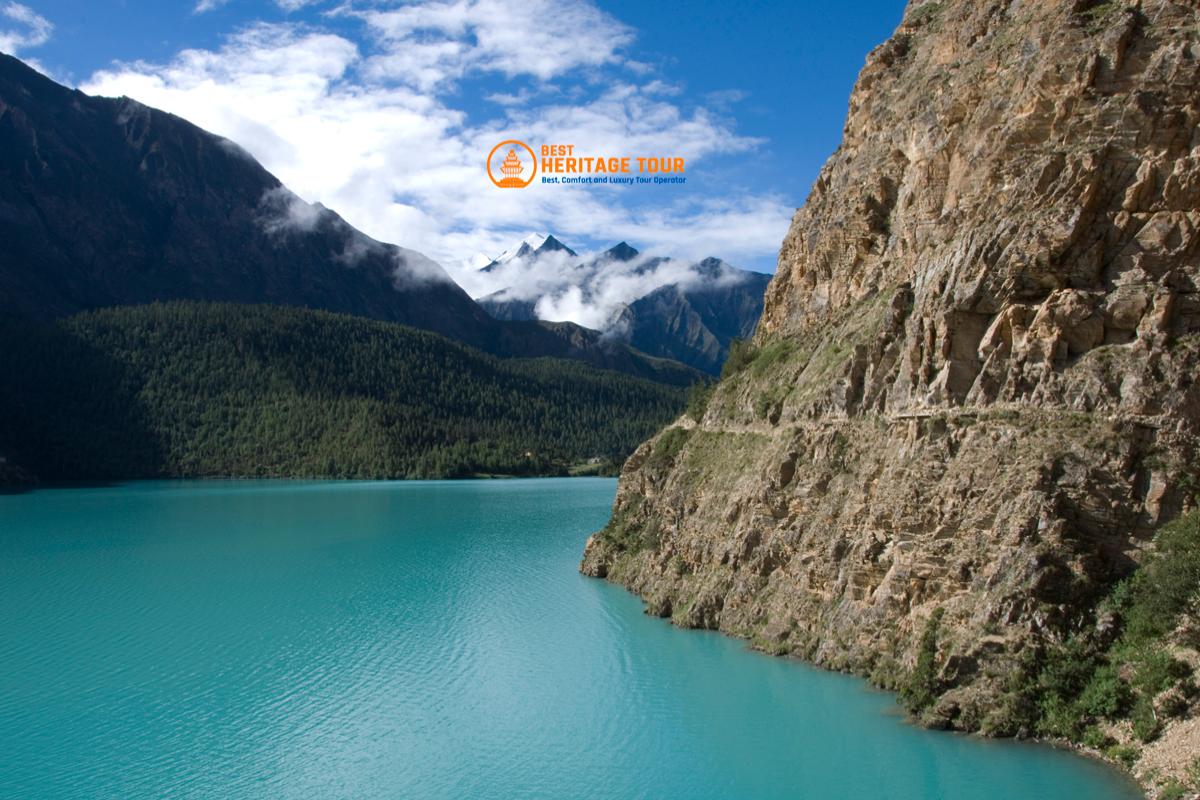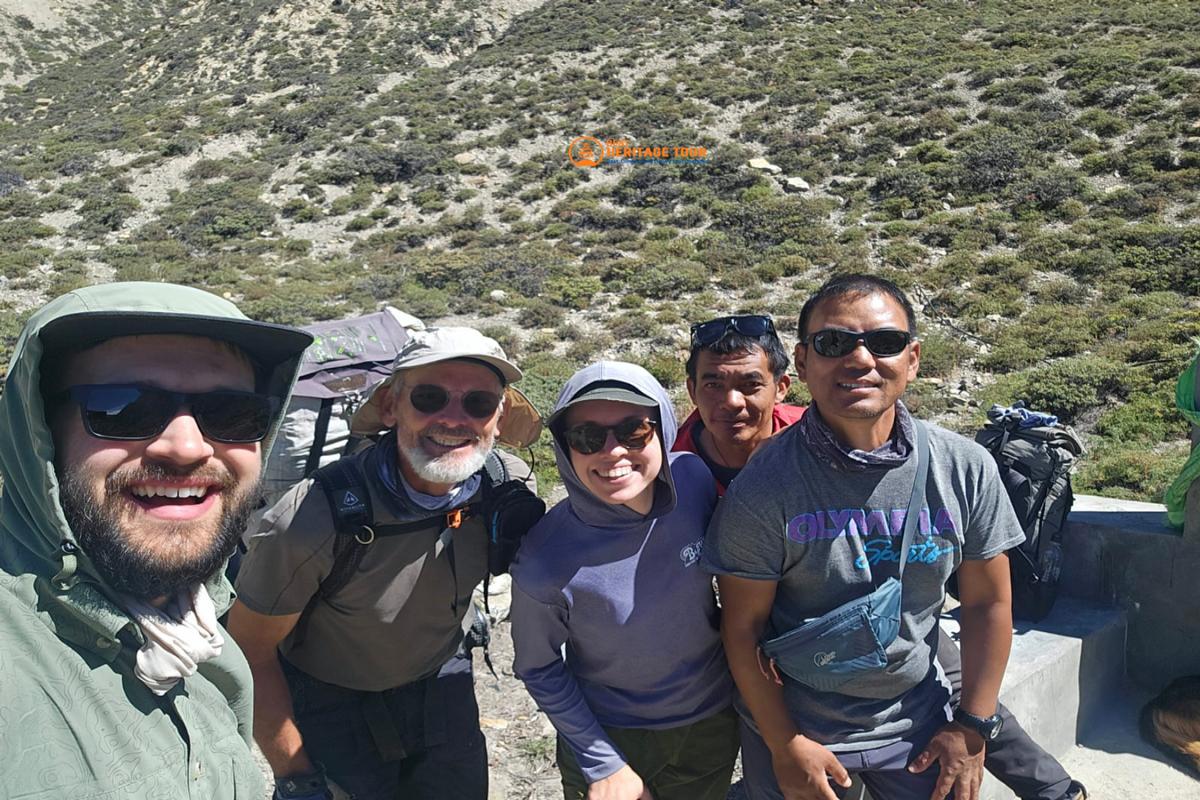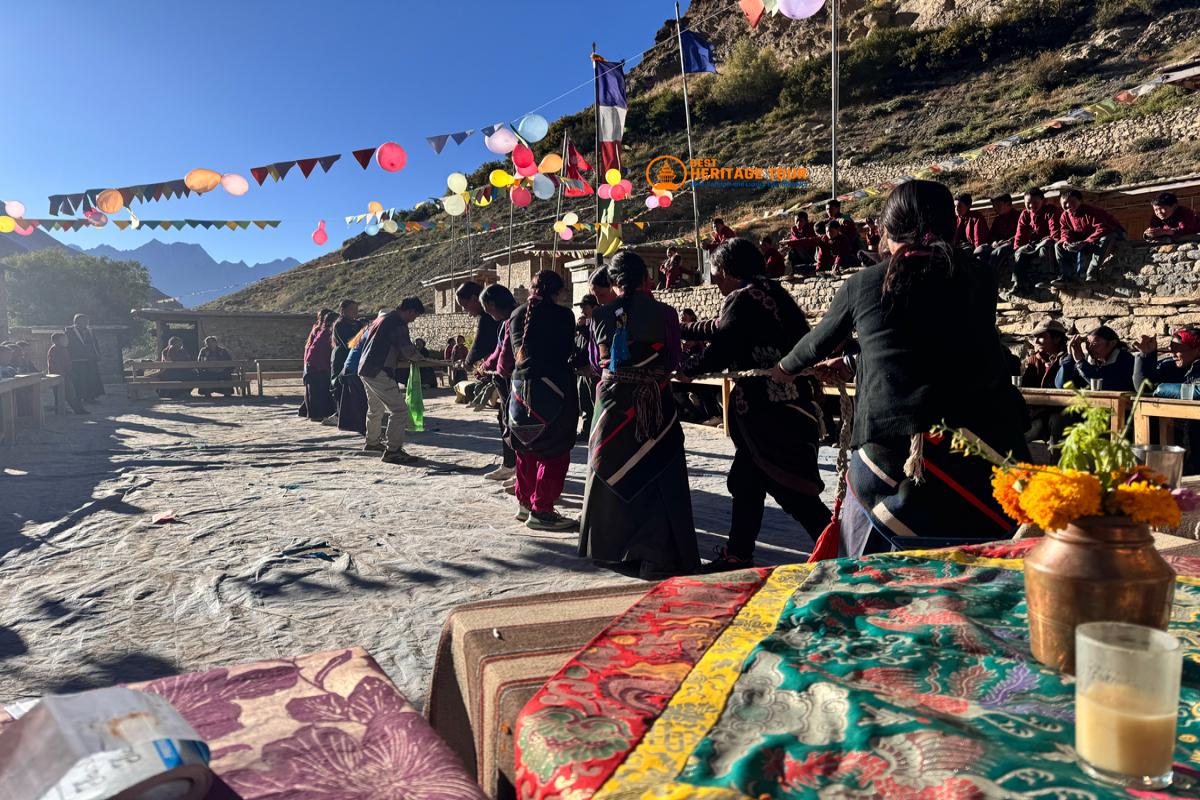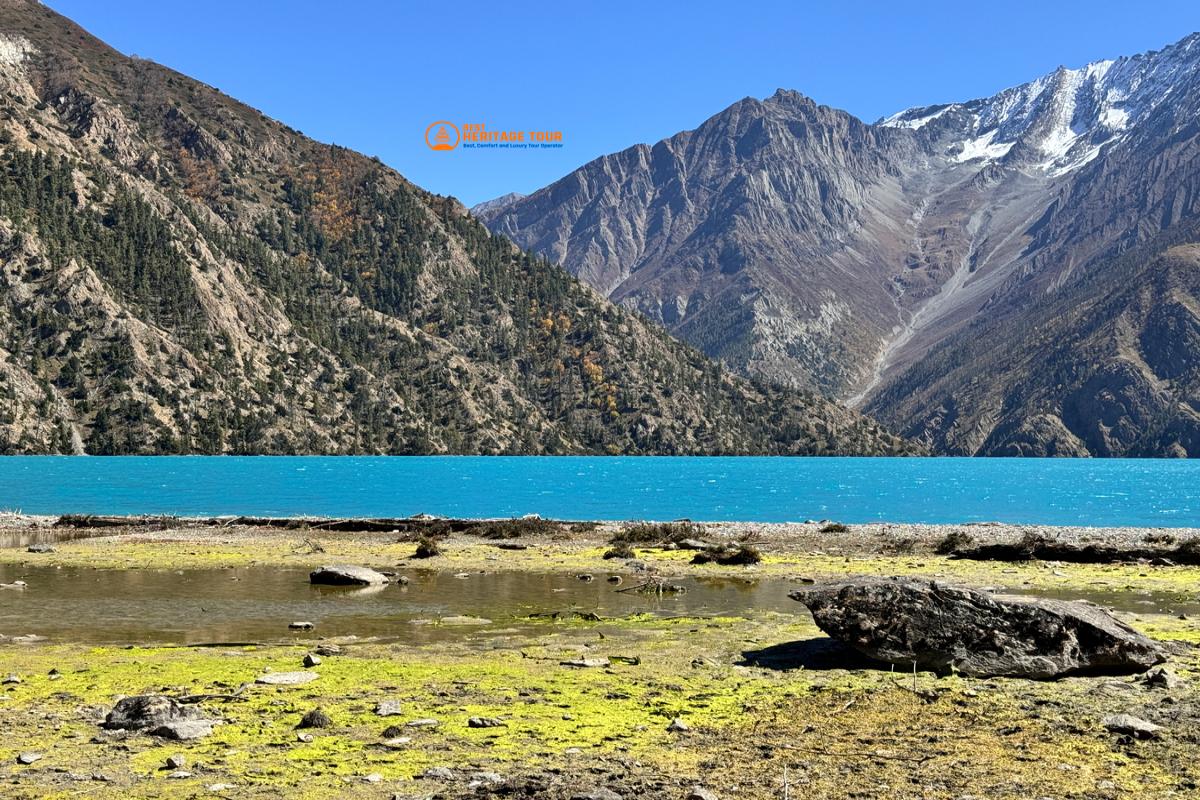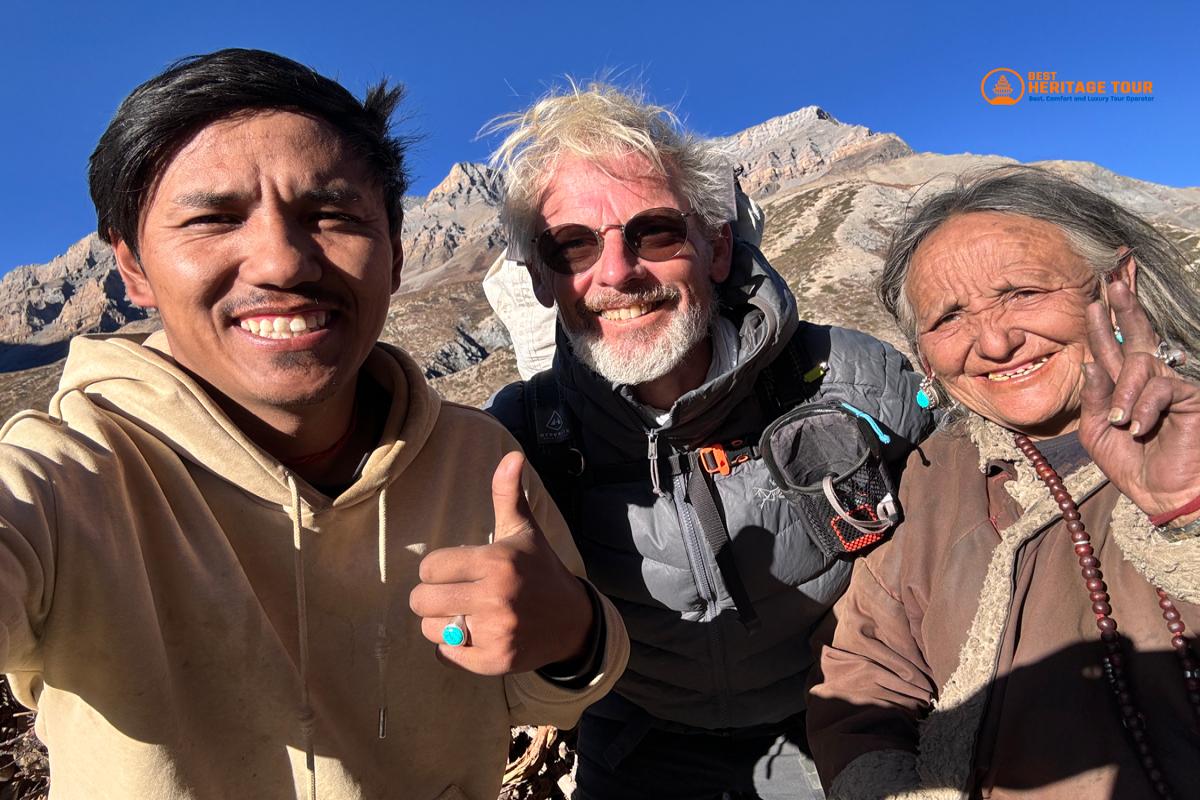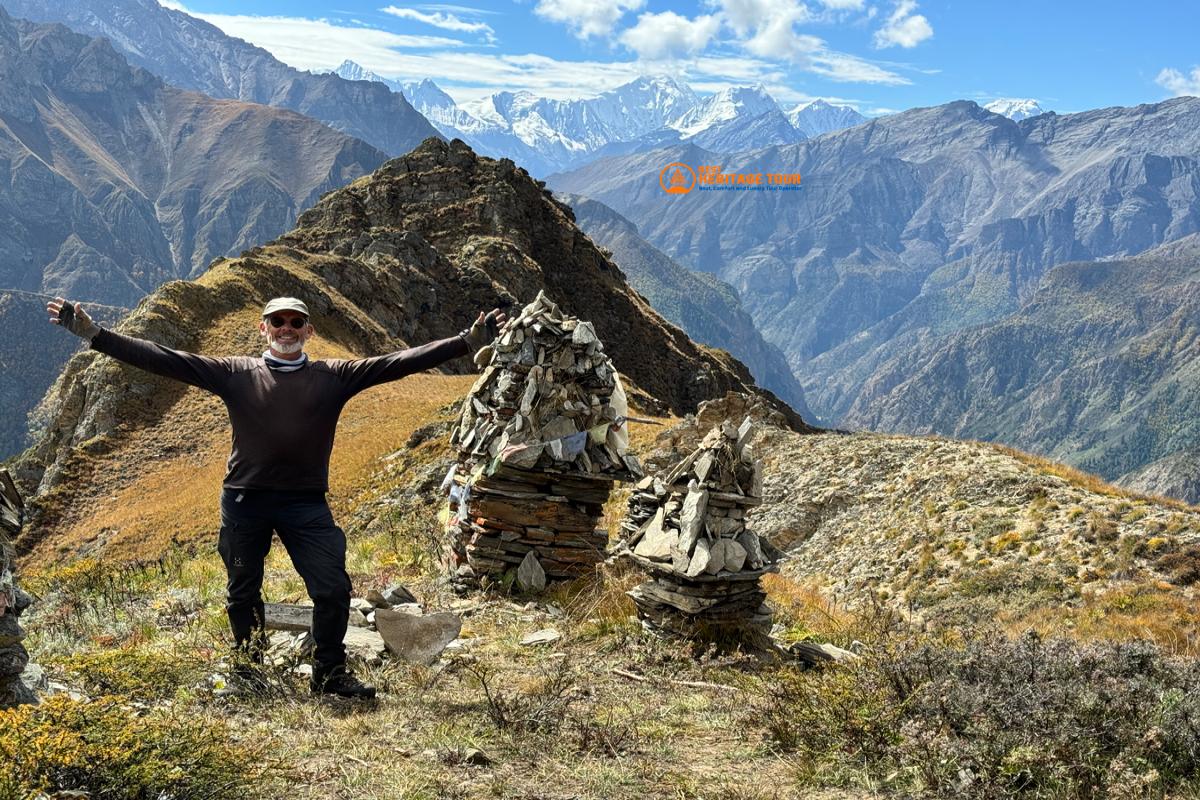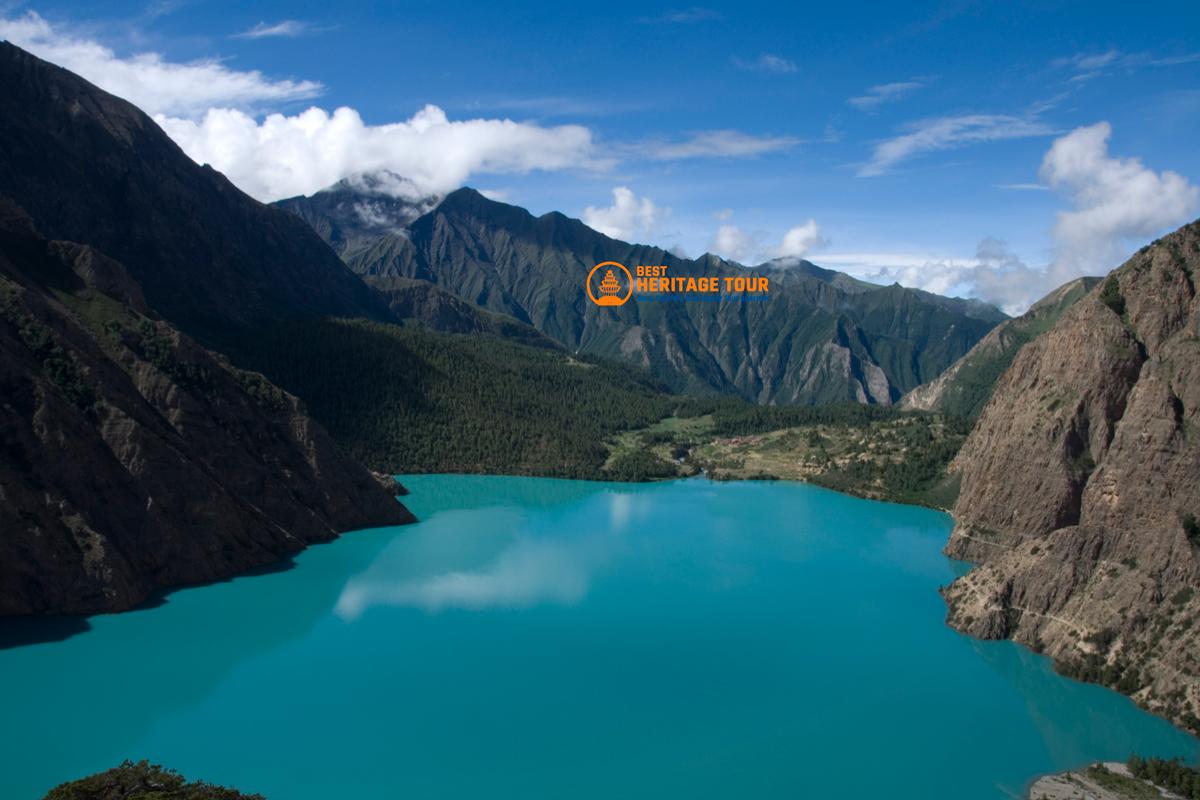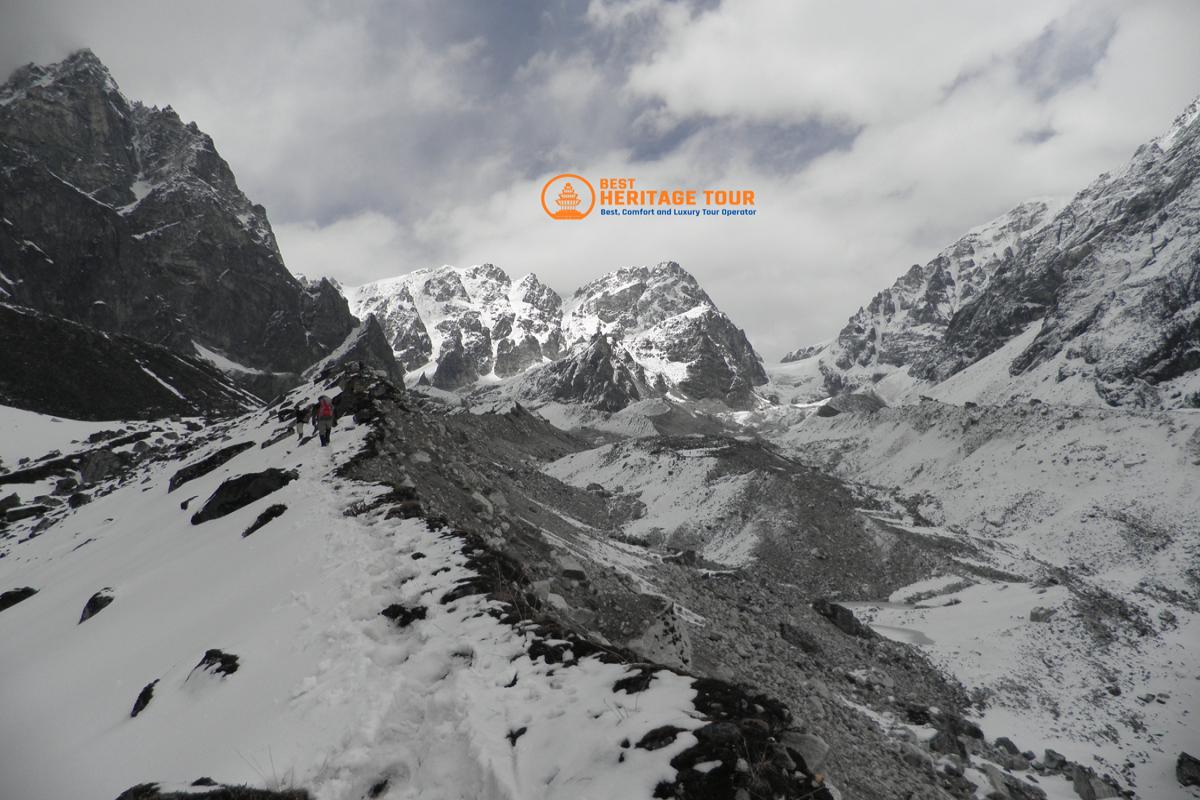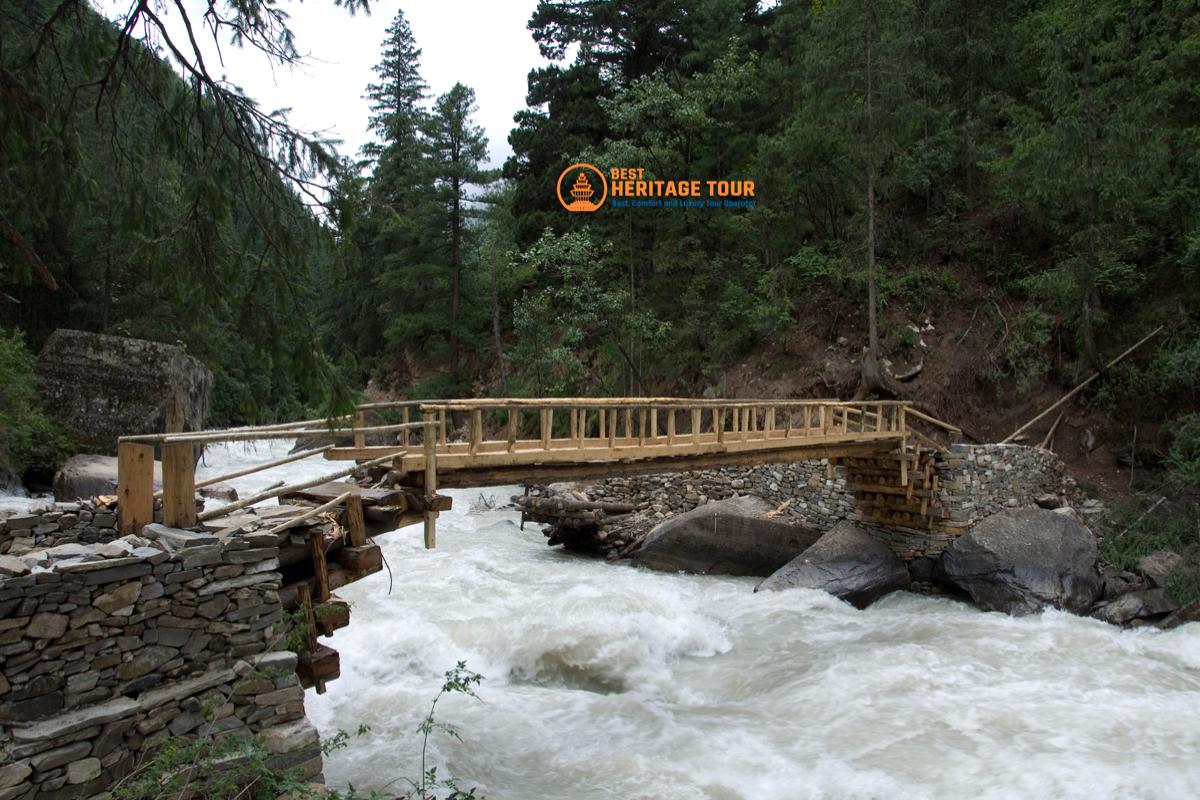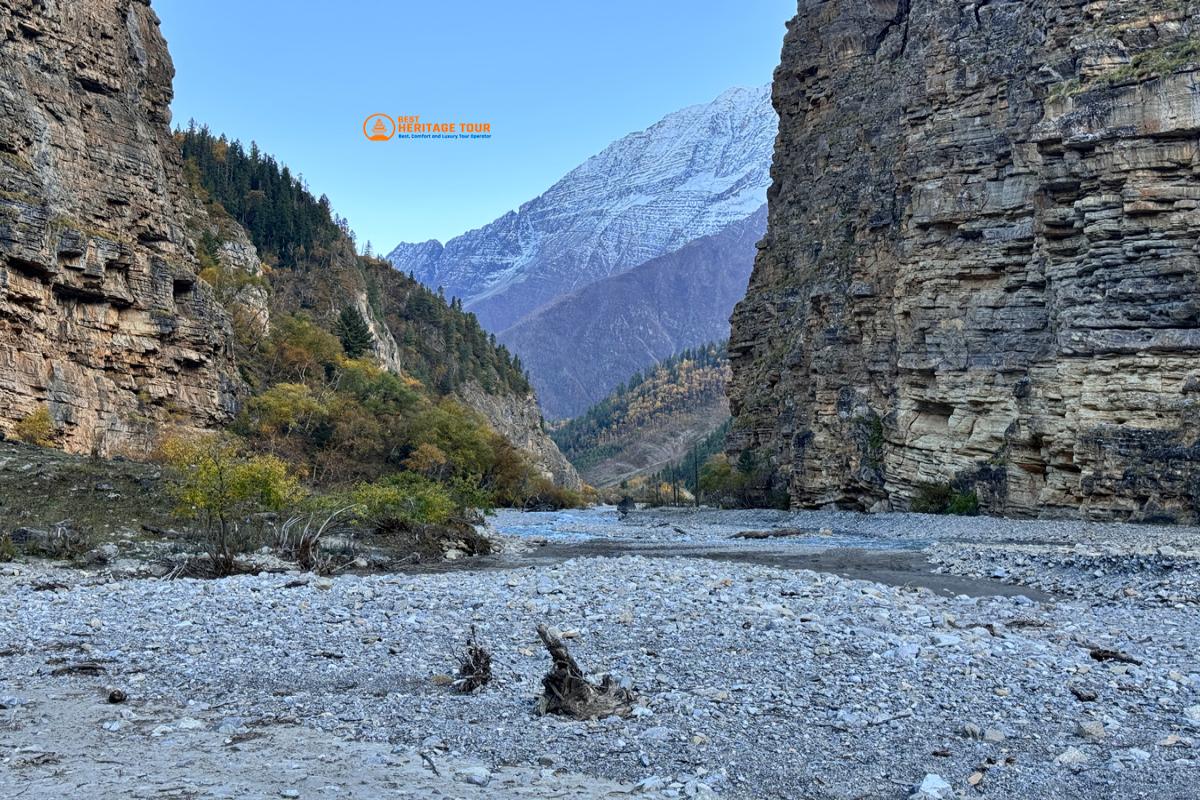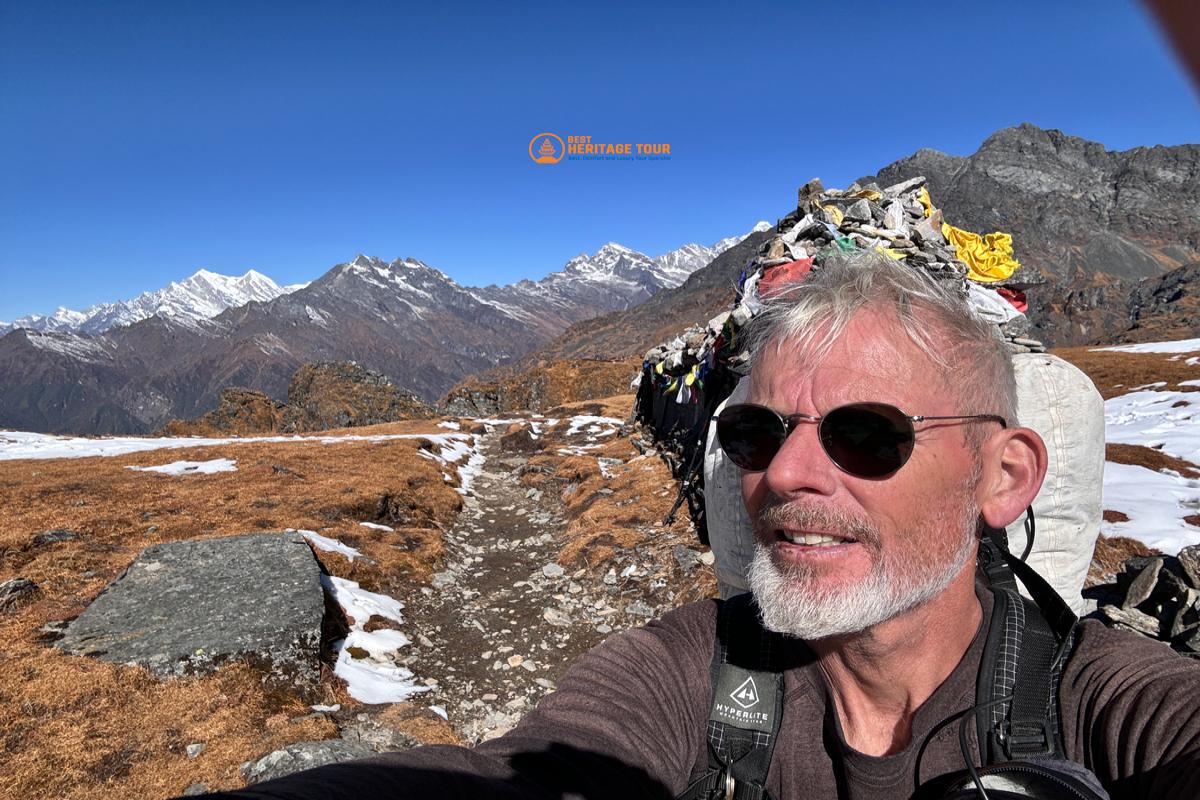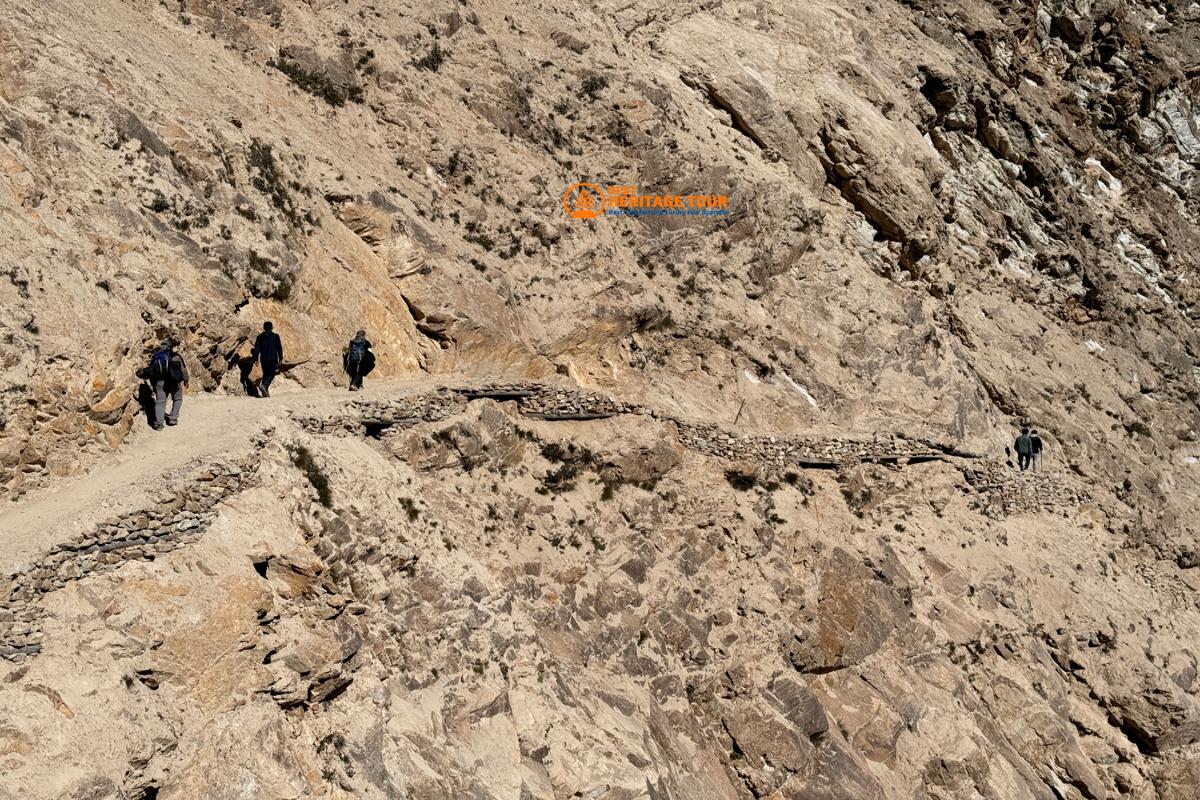Upper Dolpo Trek - 28 Days
Trip at a Glance
Key Highlights
- The trek features a variety of landscapes, ranging from lush forests to high deserts, with stunning views of the snow-covered Himalayas.
- In the Upper Dolpo area, you can find remote communities, including those with the ancient Bon-Po culture, allowing you to witness traditional lifestyles in this secluded region.
- You will visit several high-altitude lakes, such as Phoksundo Lake, known for its beauty and clarity.
- This region is rich in wildlife, home to species like the Himalayan black bear, snow leopard, and blue sheep, along with diverse plant life, including rhododendron forests and alpine meadows.
- The Upper Dolpo area is culturally and spiritually important, featuring ancient monasteries and pilgrimage sites.
- The Upper Dolpo Trek is tough and requires both physical and mental strength, but it provides a rewarding adventure and a sense of achievement.
- The trek includes crossing several high passes, like the Kang La Pass, which offers sweeping views of the peaks and valleys.
- You will explore Shey-Phoksundo National Park, a protected area rich in various plants and animals.
- The journey takes you through traditional villages, including the historic village of Ringmo, where you can immerse yourself in local culture.
- The Upper Dolpo Trek is among the least traveled and most remote in Nepal, providing a rare sense of solitude and tranquility not found in busier trekking areas.
Advantages of Choosing Upper Dolpo Trek with Best Heritage Tour
- Pickup and drop-off service at international and domestic airports
- Best Heritage Tour duffle bag
- Best Heritage Tour t-shirt
- Complimentary Lower Dolpo Trek map
- An oximeter to monitor blood oxygen levels
- Medical kits available for emergencies
- Free storage for extra luggage at the Best Heritage Tour store during the trek
Overview
Upper Dolpo is a hidden treasure in the Himalayan region of Nepal that remains largely unexplored. The Upper Dolpo Trek is a remote, high-altitude journey that showcases stunning landscapes, rich cultural experiences, and a thrilling sense of adventure. Situated in northwestern Nepal, this trek is renowned for its clear lakes, towering snow-capped mountains, and distinct local culture.
The itinerary for the Upper Dolpo Trek will guide you through the heart of the Dolpo region, allowing you to visit traditional villages and engage with the local communities. The trek begins in Juphal and leads to the secluded village of Shey Phoksundo, where you can appreciate the untouched beauty of the area. The route takes you through lush forests, over high mountain passes, and into hidden valleys, making it an ideal choice for trekkers seeking a unique experience.
A highlight of the Upper Dolpo Trek is the Shey Phoksundo National Park, which boasts a wide variety of plant and animal life. Here, you might spot blue sheep, Himalayan black bears, and snow leopards, attracting nature lovers and wildlife fans alike. The trekking trail will lead you to the charming Ringmo village, from where a short hike will take you to Shey Phoksundo Lake, situated at an elevation of 3,611 meters. This beautiful lake is encircled by steep hills and offers views of Mt. Kanjiroba in the distance. Additionally, you will have the opportunity to visit Shey Gompa, an ancient monastery.
Upper Dolpo Trekking takes you to a place that feels like stepping back in time. This remote area is home to people who live much like their ancestors did centuries ago. The culture and traditions here are deeply influenced by Tibetan ways. Locals share similar lifestyles, languages, foods, festivals, and beliefs with Tibetans. Along your trek, you will encounter various gompas and monasteries that showcase the ancient Bon Po and Chaiba cultures. The region remains untouched by modern life, allowing you to experience the pure beauty of nature and human existence during your Upper Dolpo adventure.
The Upper Dolpo Trek itinerary is tough, featuring high altitudes and rugged paths, but the stunning views and rich cultural experiences make it worthwhile. The scenery is breathtaking, and the memories you create will last forever. To make the most of your Upper Dolpo Trek, it's essential to be well-prepared. Bring the right gear, including a warm sleeping bag, quality trekking shoes, and a reliable backpack. Being physically fit and having good endurance is also crucial.
Your first day of the Upper Dolpo Trekking Package begins with a tour of the Kathmandu Valley. The day before your trek, you will fly from Kathmandu to Nepalganj, where you will spend the night before heading to Juphal. Your main hike starts in Juphal, where you will travel to Dunai and camp overnight. The following day, you will leave Dunai and make your way to Ankhe, passing through small villages and farmland. The trek continues to Sulighat and then to Phoksundo Lake. You will take a day to enjoy the views and acclimatize at Phoksundo Lake. After your day of rest, you will trek to Upper Dolpo, arriving at Phoksundo Bhanjyang after passing through a lovely meadow that takes you to the Phoksundo Khola floodplains. After crossing Kang La Pass, your next destination will be Shey Gompa, the spiritual heart of Dolpo, where you will spend another day to acclimatize.
The Upper Dolpo Trek will go from Shey Gompa to Namduna Gaun, but first, you must cross the Saldang La Pass, which is 5200 meters. After spending a night in a tent camp at Namduna Gaun, you will reach Saldang village and stay there for the night. Following the Nang Chu River to the north, you will reach Yangze Gompa, also known as Bon-Po Monastery, on the 15th day of your hike. You will retrace your steps from Yangze back through Namduna Gaun to Saldang Village and then to Sibu. To reach the base of Jeng La Pass, head east for about two hours along the Nam Khong Khola after leaving Sibu. The next morning, you will cross Jeng La Pass (5,090m) and arrive in Tokyo Gaon. From the Upper Dolpo Trekking Trail, you can enjoy breathtaking views of Dhaulagiri and other mountains. You will then leave Tokyu Gaon and head east into the Buddhist-influenced area of Dho Tarap.
You will head to Tarap Khola from Dho Tarap after a day of rest. The path mainly goes down before reaching a gorge. If luck is on your side, the Upper Dolpo Trekking route may allow you to spot Blue Sheep. Your next destination is Khanigaon, which you will reach after leaving Tarap Khola. The following morning, you will start your journey from Khanigaon to an old fort called Tarakot. To get to Dunai village from Tarakot, you will first take a trail that mostly descends. The next day, you will return to Juphal from Dunai. Your Upper Dolpo Trek concludes with a morning flight from Jhupal airport to Kathmandu, following a restful night spent there.
At the Best Heritage Tour and Research Hub, we are excited to offer our carefully crafted Upper Dolpo Trek Detailed Itinerary, promising you an unforgettable experience. Bookings are now open for 2024 and 2025. We can customize this package based on your schedule, budget, and fitness level. For any inquiries about the Upper Dolpo Trekking Package Cost, feel free to contact us.
Itinerary
Arrive at Tribhuvan International Airport, Kathmandu. A member of the delegation will meet you at the airport and drive you to your hotel. He will help you log in and inform you about your daily life. Later in the evening, you will meet your guide to discuss your Upper Dolpo hiking itinerary.
After breakfast, start your narrated sightseeing tour of Kathmandu. The sacred Pashupatinath Temple, Boudhanath Stupa, Swayambhunath (also known as the Monkey Temple), and Kathmandu Durbar Square are all included in the itinerary. All these sights are famous tourist destinations and UNESCO World Heritage sites. Then, together with your guide, you will be inspected and prepared with all the equipment and documents required for the hike. In the evening, you will stroll through the vibrant streets of Thamel.
You will start your Upper Dolpo trekking journey today with a domestic flight from Kathmandu to Nepalgunj in western Nepal. The 1-hour flight will take you through the stunning scenery of the Terai region. Upon arrival in Nepalgunj, check into your hotel. Nepalgunj is located near the Indian border and is one of the most vibrant cities in Nepal. Here you can visit the local market and town as well as the mini zoo.
After a hearty breakfast, fly from Nepalgunj to Juphal. During the flight (8,167m) you will enjoy breathtaking views of Mt. Dhaulagiri and Mt. Annapurna (8,091m). Today you will meet the rest of the crew and start the most exciting Upper Dolpo trekking trip of your life. Trekking through the terraced fields you will reach the Beri River. From here the route will take you to Dunai, the administrative center of the Dolpo region.
Leaving Dunai behind, cross the suspension bridge and head west along the forest road. The Upper Dolpo trekking trail continues climbing until it reaches the Thulo Bheri valley. Along the way, you can enjoy the magnificent views of the Kagmara Peak. The path then passes through small towns and walnut plantations. Once you reach Ankhe, you will descend through the forest and spend the night in a tented camp.
You will climb a challenging route while walking along the forested riverbanks. Today's hike involves a lot of ascents and descents, but there are plenty of streams along the way to keep your cool. After leaving the trees behind, the Upper Dolpo trekking path continues over grassy hills. It then goes through dense forests to reach a cliff. From here, it's down a rickety staircase. Be careful. Continue hiking from the riverbank until you reach Sulighat.
Today we hiked to the confluence of the Phoksundo and Phungmo rivers. From here, we cross a bridge and walk along the western bank of the Phungmo Khola. The Upper Dolpo trekking route continues through cedar forests to the hamlet of Palam. We then climb a ridge and descend through lush green birch trees. After Phoksundo Khola, the hamlet of Ringmo comes into view. From here it is a short walk to Phoksundo Lake.
According to the Upper Dolpo trekking itinerary, this is a relaxing day to acclimatize to the high altitude. Spend the day on an excursion to visit Ringmo village, where you will see an ancient Tibetan Buddhist monastery. You will be able to observe the daily activities of the local people and their wider culture and traditions. Afterward, you will spend some time enjoying the magnificent views of the amazing Phoksundo Lake and its surroundings.
While hiking along the western bank of Phoksundo Lake, you will encounter crevasses. The path becomes rough and unstable. The Upper Dolpo trekking trail runs from the westernmost edge of the lake across green pastures to the plains of Phoksundo Khola. From here, you will go through a valley and build a bridge over the river. You will reach Phoksundo Khola and spend the night there. You will stay in a tent for the night.
At the Upper Dolpo trekking route, Phoksundo Khola meets another stream at a junction, leading north through a glacial valley. Continuing northeast, you cross a dilapidated bridge and come across a beautiful sheep farm. The route climbs to the top of a steep valley, from where you can enjoy a magnificent view of the Kang La Pass. You will also enjoy breathtaking views of Chamlang Peak 6th (6,739m) and Peak 7th (6,105m).
Early in the morning, start your climb up the steep path to the pass. The climb is difficult but the views of the surroundings from the top are amazing. There is also a steep descent and a walk along the river. You will hike through pastures and cross this river several times at various points. Several yaks, mountain goats, and sheep graze in the pastures. After crossing a wooden bridge, we finally reach Shey Gompa where we spend the night.
The Upper Dolpo trekking itinerary states that today is the second acclimatization day at Shey Gompa. Our destination is the ancient Shey Gompa monastery built in 1655. The monastery is known for its huge bronze seated Buddha statue covered in gold plating. To the east of the gompa is Crystal Mountain, which can be visited. This cliff is covered with quartz and various marine fossils, making it one of the strangest mountains in all of Nepal. Subsequently, we will explore the village of Shey, where you will have the opportunity to witness the Bon Por lifestyle.
The Upper Dolpo trekking trail descends from the juniper trees, leading into a rocky valley. From here, you can hike to the top of Saldang La pass along a zigzag path through the rocky terrain. The route then turns south towards Namduna Gaun. Enjoy beautiful views of sheep and yaks grazing in the pastures along the trail. In Namduna Gaun, you will visit the ancient Namduna monastery made of red stone.
The Upper Dolpo trekking route starts today from Namduna Gaun. From there, you will start climbing uphill and walk along a dusty path to Saldang. After 3-4 hours of strenuous climbing, you reach an altitude of 4800m. Then you descend a steep hill to reach the charming settlement of Saldang on the plateau above Nam Khong Nara. Saldang is the largest village in the Lower Dolpo region, wealthy both for agriculture and its convenient location on the trade route to Tibet.
Your day starts with a hike through a deserted area along Nagon Khola in the north. Today's trekking trail in the upper Dolpo is very easy with very little ascent or descent. Then you will cross the Panzang River after passing through Marang and Ki villages. When you reach Yangze Gompa, an ancient Bon Po monastery, the route turns east and crosses another river to reach it.
There are two ways to get to Sibu. The easy route takes you back to Saldang village. To get from Saldang to Namdo village, you will have to hike along the river past stupas, chortens, terraced fields, and mani stones. After visiting Namdo monastery, continue the trekking route through Upper Dolpo for another 2 hours to reach Sibu.
The Upper Dolpo trekking route runs alongside the caravan along Nam Khong Khola. As you continue hiking eastward you will eventually reach the confluence of two small rivers. From here the challenging route continues down to the meadows below Jeng La Pass. You will spend the night in the beautiful grassland.
You will wake up early this morning to start your adventure to Tokyu Gaon. The first stage of the Upper Dolpo trekking path continues up to Jen La pass, where a breathtaking panorama of the northern face of Dhaulagiri (8167m) awaits you. The path then descends onto a rocky track that leads to the Tarap Valley. From here you will trek to Tokyu Gaon, where you will spend the night.
While going down into the flat valley, you will walk through grassy fields that provide fresh views of the Dolpo region. During your journey, you will pass through wetlands that are typical of the desert mountain region. Further, the Upper Dolpo trekking route from here will take you to the hamlet of Daw Tarap, surrounded by curved stone walls. This is also a chance for you to engage with the distinctive Bon Po and Chaiba religions.
According to the Upper Dolpo trekking itinerary, this is the third rest day for altitude acclimatization at Daw Tarap village. This rest day will help you acclimatize to the environment and give you a chance to explore the community and its surroundings. Talk to the local people and learn about their lifestyle, culture, and traditions. The religions practiced here are Chaiba and Bon Po, and you can taste their products and admire their beautiful costumes.
The Upper Dolpo trekking trail leads from Dho Tarap into a wide valley that opens into a narrow gorge. Hike among junipers and wild roses and spot a flock of blue sheep. Reach the confluence of Lang Khola and Tarap Chu. Spend the night in a tented camp next to Tarap Khola in a beautiful grassland called Kamakharka.
After breakfast, hike to the Tarap River valley. You can see locals grazing their cattle in the undergrowth beside the road. The Upper Dolpo trekking route also goes through a very small valley where you can easily jump from one place to another. It will be a challenging hike. Crossing a small river on foot makes the hike even more exciting as the bridges may be destroyed or washed away.
Reach Lalberi village via the Upper Dolpo trekking route. The route then passes through a dense forest area and descends into another gorge. Walking through the valley, you will eventually come to a river. You can reach Tarakot by hiking along the riverbank where Sandur Gompa is located. The confluence of Barbung Khola and Tarap Chu is 8 km east of the town where the gompa is located. Rest in Tarakot and spend the night in a tent city.
Hike back to Dunai by the same route. After crossing a bridge near Rawang village, trek along the bankside of the Beri River. Then climb up to Beas Gadi on the Upper Dolpo trekking trail, then head west on an easier route. After crossing the river near Lochakhola Gaon, climb up and reach Dunai, where you will spend the night.
Trek along the Beri River and enjoy the breathtaking views along the route. You will also pass through the villages of Dhupichaur and Rupgad. You will walk through the villages of Motipur and Kalagaonda, then continue on the Upper Dolpo trekking path to a small airstrip. Here, you will take a flight back to Juphal.
Depart Juphal early in the morning and after breakfast, take a short scenic flight to Nepalgunj. Flying over the Himalayan foothills, the aircraft offers breathtaking views of the northern peaks, including Annapurna and Dhaulagiri. Your Upper Dolpo trekking itinerary ends with your arrival in Nepalgunj and a flight back to Kathmandu. Once you reach Kathmandu, check into your hotel and take the day to relax. You will be staying overnight in a 3-star hotel.
Today you have free time in Kathmandu. You can relax and spend the day shopping or exploring the surrounding area. If you wish, we can organize a guided tour to see the sights you may have missed. Tonight, we will celebrate the success of our Upper Dolpo trekking trip with a lovely farewell dinner before leaving for our home country tomorrow.
Our exciting hike around Nepal with you has come to an end. After breakfast today we will drive to the airport. A member of our team will assist you to the international airport terminal gate before bidding you farewell.
Our team leaders, porters, and support staff are locals and have a wealth of knowledge about every place we travel to.
Customize your trip
What is included?
- All land travel will be by private vehicle, which includes transfers to and from the airport
- Four nights in Kathmandu with breakfast
- Kathmandu Valley sightseeing tour (including guide, entrance fees, and private vehicle)
- Full board meals (breakfast, lunch, dinner, tea, and coffee) prepared by an experienced chef
- Accommodation in tented camps for 2 people during the hike
- A very experienced guide, Sherpa, required several porters and their food, accommodation, salary, insurance, and equipment.
- Trekking equipment (tent for 2 people, dining tent, kitchen tent, table with chairs, cooking utensils, and other equipment required during the trek)
- Air tickets from Kathmandu to Nepalgunj and then to Juphal or vice versa (including departure tax)
- One-night stay in Nepalgunj with breakfast
- Best Heritage Tours travel bag, down jacket, and sleeping bag during the trek
- Best Heritage Tours T-shirt and trekking map
- Safe boiled drinking water is provided during the trek.
- Comprehensive first aid bag
- All necessary permits and documents, including the special permit for upper Dolpo
- All state and local taxes
- Administrative fees
What is not included?
- Any meals that are not specified in the "included meals" section of the itinerary.
- Travel insurance – mandatory
- International flight ticket
- Nepal entry visa
- All cold drinks, including alcoholic beverages, mineral water, cola, Fanta, juices, etc.
- Personal shopping and laundry, telephone, internet charges, etc.
- Personal trekking equipment
- Tips for the trekking team
Route Map
Trip Info
What to Expect from the Upper Dolpo Trek?
The Upper Dolpo Trek is a tough yet fulfilling adventure through the hidden treasures of the Himalayas in Nepal. Here’s what you can look forward to on this trek:
- You will experience breathtaking scenery, including clear lakes, towering snow-covered mountains, and secluded valleys.
- The route takes you through traditional villages, allowing you to meet local people and discover their distinct culture and lifestyle.
- The trek includes Shey Phoksundo National Park, which is rich in wildlife, featuring species like blue sheep, Himalayan black bears, and snow leopards.
- Although the trek is demanding due to high altitudes and rugged paths, the experiences gained are incredibly rewarding.
- Its remote setting provides a chance to avoid crowds and enjoy the tranquility of the area.
- A good level of fitness, stamina, and preparation is necessary to make the most of this journey.
In summary, the Upper Dolpo Trek combines breathtaking views, cultural richness, and a spirit of adventure, making it an essential destination for trekkers and nature enthusiasts.
Is the Upper Dolpo Trek Appropriate for You?
The Upper Dolpo Trek is challenging, but it can be suitable for many types of trekkers, such as:
- If you have some trekking experience and want to take on a new challenge, this trek could be ideal for you.
- If you seek adventure and are ready to test your physical and mental limits, the Upper Dolpo Trek provides a memorable experience.
- If you love wildlife and nature, this trek features a variety of plants and animals, including blue sheep, Himalayan black bears, and snow leopards.
- If you want to explore different cultures, the trek passes through traditional villages, allowing you to meet locals and learn about their lifestyles.
Keep in mind that the Upper Dolpo Trek demands good physical fitness, endurance, and preparation. It takes place at high altitudes and includes rough paths, so being well-prepared with the right gear is essential for a great experience.
Preparation for the Upper Dolpo Trek
Effective preparation is crucial for a successful and enjoyable experience on the Upper Dolpo Trek. Consider the following essential steps when getting ready for the journey:
- Achieving a good level of physical fitness is vital for the Upper Dolpo Trek, which entails long hiking days at high altitudes across challenging terrain. It is advisable to begin your fitness regimen well in advance, focusing on regular exercise to enhance your endurance.
- Given that the Upper Dolpo Trek is situated in a remote region, having the appropriate gear is necessary to ensure warmth and comfort. This includes suitable clothing, footwear, a quality sleeping bag, and a reliable backpack.
- Due to the high altitude of the Upper Dolpo Trek, proper acclimatization is important to prevent altitude sickness. It is advisable to spend a few days acclimatizing at lower elevations before commencing the trek.
- Obtaining travel insurance is imperative for any trekking adventure, particularly one as demanding as the Upper Dolpo Trek. Ensure that your insurance policy includes coverage for emergency evacuation and medical treatment.
- Conducting thorough research on the trek and planning your itinerary can enhance your experience and help mitigate potential issues.
- Engaging a local guide is highly recommended for the Upper Dolpo Trek, as they possess valuable local knowledge and experience. They can assist with navigation and provide support in case of any challenges.
By adhering to these guidelines, you can effectively prepare for the Upper Dolpo Trek, ensuring a safe and enjoyable adventure.
Upper Dolpo Trek Cost 2024 and 2025
The Upper Dolpo Trek Cost starts from USD 4450 per person.
Best Heritage Tour offers the 28-Day Upper Dolpo Trek Cost based on group size. Please follow the below table for the group price details:
|
No. of Pax |
Starting Price |
Action |
|
2 |
USD 4525 per person |
|
|
3 |
USD 4500 per person |
|
|
4 |
USD 4450 per person |
Note: If you want to discuss the Upper Dolpo Trek Itinerary and Cost, feel free to Contact or WhatsApp us. We are available 24x7 for you.
Useful information
Best Time, Season, and Month for Upper Dolpo Trekking
The perfect time for trekking in Upper Dolpo, Nepal, is from May to October. The weather during this time is generally stable and sunny, with warm days and cool nights. The monsoon season lasts from June to September, but the region is relatively dry and receives less precipitation compared to other parts of Nepal. May and June are the best months for hiking as visibility is good and skies are clear. July and August see warmer temperatures and the monsoon season is in full swing, so it's important to prepare for rain and mud on the way.
September and October are considered the best months for hiking in the Upper Dolpo region as the monsoon season is over and the weather is dry and sunny. The skies are usually clear during this time, offering breathtaking views of the surrounding mountains and valleys.
So, the best time to do Upper Dolpo trekking is September and October as the weather is dry and sunny, providing the best hiking conditions. However, the weather in the area can change quickly and unpredictably, so it's important to check the weather forecast and trail conditions before starting your hike.
Meals
The Upper Dolpo trekking region is remote and lacks infrastructure, so access to food and meals can be an issue. You will be provided with 26 breakfasts, 22 lunches, and 23 dinners throughout the trip. There are a few ways to ensure you get enough nutritious food during your trip:
- Packaged meals: You can organize packaged meals that are easy to carry around, such as energy bars, trail mix, and dried fruit. These provide a quick and easy source of energy while hiking.
- Teahouses: Several teahouses along the hiking route serve simple meals such as dal bhat (lentil soup with rice), noodles, and potatoes. These meals are simple but filling and a good source of carbohydrates.
- Camping Treks: Camping trekkers are provided with a chef and kitchen staff, and meals are freshly cooked on-site.
We recommend bringing extra food such as snacks, energy bars, and dry fruits in case you run out of food at the teahouse. It is important to stay hydrated and drink plenty of fluids throughout your trip to avoid altitude sickness and other health problems. Clean drinking water can be found in streams, rivers, and lakes, but we also recommend bringing water purification tablets and a water purifier with you.
Accommodation
During the Upper Dolpo Trek, you will mainly stay in teahouses or campsites. Here is what you can expect:
- Teahouses are modest accommodations that supply essential lodging and meals. Rooms are usually shared and come equipped with basic amenities such as mattresses, blankets, and pillows. Teahouses along the Upper Dolpo trekking route are often rustic and simple but offer a unique and authentic experience.
- Camping Trekkers are provided with tents and a chef and kitchen staff will prepare the meals and set up camp. Camping offers a more rugged and adventurous experience but also requires a higher level of preparation and planning.
No matter which option you select, be ready for a basic and rustic setting since the Upper Dolpo area is remote and has limited facilities.
Trek Difficulty Level
Upper Dolpo hikes are considered challenging hikes and are not suitable for inexperienced hikers or those with low physical fitness. The trek involves multi-day hikes through rugged, rough terrain and continues to high altitudes, making it physically and mentally taxing. Challenges of the Upper Dolpo hike include:
- Elevation: The hike reaches an elevation of up to 5,400 meters. Therefore, it is important to acclimatize properly and watch for symptoms of altitude sickness.
- Terrain: The hike involves hiking in rough, steep terrain, including rocky paths and steep climbs and descents.
- Remoteness: The Upper Dolpo hiking trails are located in remote and isolated areas. Therefore, it is important to be prepared for potential challenges, including poor trail conditions and limited access to basic needs.
- Weather: The weather in this region can change quickly and unexpectedly, so it is important to be prepared for any situation.
In short, the Upper Dolpo trek is a challenging trek that requires a good level of fitness and preparation. If you are skilled and ready, the Upper Dolpo trek will offer you a special and memorable adventure. However, if you are less experienced or in low fitness, we recommend that you consider a less taxing trek.
Travel insurance is required during the Upper Dolpo trek
We strongly recommend that anyone undertaking the Upper Dolpo trekking has travel insurance. As the trek is in a remote area, it is important to have insurance in place to cover any unforeseen circumstances like injury, illness, or evacuation. Here are the main benefits of having travel insurance for the Upper Dolpo Trek:
- Emergency medical expenses: Travel insurance covers medical expenses in case of injury or illness during the hike.
- Emergency evacuation: Travel insurance can cover the cost of emergency evacuation in case of a medical emergency or other situation that requires immediate attention.
- Trip cancellation or interruption: Travel insurance covers you if you have to cancel or interrupt your trek due to unforeseen circumstances like a family emergency or illness.
- Loss or theft of equipment: Travel insurance provides coverage for the loss or theft of equipment.
Travel insurance is very important when preparing for the Upper Dolpo trek. It provides safety and financial protection in case of any unforeseen events and is essential for anyone undertaking this challenging trek.
Altitude Sickness During the Upper Dolpo Trek and Its Treatment
Altitude sickness, also known as acute mountain sickness (AMS), is a common problem for trekkers in the Upper Dolpo region whose treks reach an altitude of 5,400 meters. It is caused by reduced oxygen levels at high altitudes and can lead to a range of symptoms including headaches, nausea, dizziness, and shortness of breath. Here are some treatments and tips to prevent and manage altitude sickness during the Upper Dolpo trek:
- Gradual Ascension: Gradual acclimatization to the altitude with rest days and no more than 300-500 meters of elevation gain per day helps prevent altitude sickness.
- Hydration: Maintaining proper hydration is essential in order to avert altitude sickness. Stay hydrated by drinking lots of water. Try to stay away from alcohol and caffeine since they can lead to dehydration.
- Proper nutrition: A balanced diet high in carbohydrates will help your body adapt to the high altitude.
- Medications: Diamox is a commonly prescribed medication for altitude sickness, but it is important to consult your doctor before taking any medication.
- Descent: If you experience any symptoms of altitude sickness, it is important to descend to a lower altitude immediately. It is important to take altitude sickness seriously and recognize the symptoms.
If symptoms appear, it is best to immediately exit the vehicle and seek medical attention. Taking proper precautions can reduce the risk of altitude sickness and ensure a safe and enjoyable hike in the Upper Dolpo region.
Packing List, Equipment, and Accessories for the Upper Dolpo Hike
When preparing for an Upper Dolpo hike, it is important to pack carefully to ensure you have everything you need for the hike. Here’s a basic packing list to help you begin:
- Backpack: A sturdy, comfortable backpack with a capacity of at least 40 liters is essential to carry your gear on the hike.
- Clothing: Wear several layers of clothing that can be easily put on and taken off depending on the weather and temperature. These include thermal underwear, a fleece jacket or sweater, an insulated jacket, a waterproof and windproof outer layer, hiking pants and shorts, a lightweight t-shirt, a sun hat, and gloves.
- Shoes: Quality hiking shoes with strong ankle support are essential for the Upper Dolpo trek. Pack comfortable sandals or sneakers for camping.
- Sleeping gear: You will need a warm and comfortable sleeping bag and sleeping pad for camping.
- Cooking equipment: light stove and fuel, pots, bowls, and utensils for cooking and eating.
- Hydration: hydration system, water bottle or bladder, and water purification tablets or a filtration system.
- First aid kit: personal first aid kit with essentials such as painkillers, blister medication, and altitude sickness medication.
- Toiletries: items for personal care like toothbrushes, toothpaste, wet wipes, and toilet paper.
- Other: sunscreen, sunglasses, headlamp or flashlight, camera, personal documents such as passport and insurance details.
This list is just a starting point and can change based on your personal needs and the details of your hike. To ensure a comfortable and enjoyable hike in the Upper Dolpo region, it is important to pack lightly and bring only the essentials.
Upper Dolpo Trek Guide and Safety Tips
Choosing a skilled and experienced guide for the Upper Dolpo Trek is essential for a safe and enjoyable journey. A guide offers important insights into local culture, plants, and animals, and helps navigate tough paths while managing any surprises. Here are some key points to think about when picking a guide for the Upper Dolpo Trek:
- Make sure your guide has a valid license and significant experience in the Upper Dolpo area.
- Your guide should know the trek route well and navigate it safely.
- Your guide should be trained in safety measures, including first aid and emergency procedures.
- Consider the size of your group and the guide's ability to manage it, ensuring everyone's safety.
- Confirm that your guide speaks English well to communicate effectively with the group.
Besides hiring a knowledgeable guide, it's vital to prepare for the Upper Dolpo Trek and take responsibility for your safety. This means recognizing altitude sickness symptoms and taking precautions, as well as sticking to the designated trek route and avoiding dangerous activities. By following these tips and your guide's advice, you can have a safe and enjoyable trek in the Upper Dolpo region.
Upper Dolpo Trek Booking Process
Join Best Heritage Tour, a top trekking company in Nepal, for the best price on the Upper Dolpo Trek Package. We have skilled guides and are fully registered and approved by the government (registration number 71671/066/067). We are also connected with various national tourism organizations, such as the Nepal Tourism Board (NTB), TAAN, NMA, KEEP, and more. Trekking with us guarantees an unforgettable experience, as we are highly recommended by many groups. We invite you to become part of the Best Heritage Tour family. To book, just pay a 10% deposit now and settle the rest upon your arrival.
FAQ's
Yes, all our guides are fluent in English and many speak other languages. This facilitates clear communication and enhances your overall experience.
Most trekking guides in Nepal speak basic to advanced English, which is enough for general communication about trekking and safety precautions. Some speak more fluent English, which will improve your overall trekking experience.
Yes, most visitors need a tourist visa to enter Nepal. A visa can be obtained on arrival at Tribhuvan International Airport in Kathmandu or applied for in advance at a Nepalese embassy or consulate.
Yes, you will need two passport-sized photos for both the visa application and the trekking permits, so it's a good idea to bring extra copies just in case.
You'll need a valid passport (with at least six months validity), a passport-sized photo, and the visa fee (which varies depending on the duration of stay).
To obtain the RAP, you’ll need:
- A valid passport.
- A Nepal visa.
- Travel insurance.
- Two passport-sized photos.
- A letter from your trekking agency detailing your itinerary and the names of the guide and group.
Yes, it’s possible to extend your visa if you wish to stay longer in Nepal. Extensions can be processed at the Department of Immigration in Kathmandu or Pokhara, but you should apply before your current visa expires.
You can exchange US dollars or Euros for Nepalese rupees upon arrival, but we recommend carrying cash in the local currency for most transactions outside of major cities.
Hygiene standards may vary. Most teahouses strive for cleanliness, but it is wise to temper your expectations, especially in remote areas.
Yes, teahouses are generally safe and many hikers have had good experiences with them, but it's wise to use common sense, lock up your valuables, and choose a reputable establishment recommended by your guide.
To ensure you are comfortable while trekking, your backpack should ideally weigh 10-15% of your body weight, usually around 10-15 kg (22-33 lbs).
Physical preparation is essential to a successful trekking experience. Begin an exercise program 6-8 weeks before your hike that focuses on:
- Aerobic exercise: Activities such as running, cycling, and swimming to improve endurance.
- Strength training: Leg, core, and upper body exercises to increase strength.
- Practice hiking: Fill up your backpack and go on a short hike to simulate trekking conditions.
Hiring porters is not mandatory but highly recommended. Carriers allow you to carry heavy loads and make the hike more comfortable. This also supports the local economy and creates jobs in the area.
It is important to stay hydrated while climbing. Bring a reusable water bottle and use water purification tablets or a filter if necessary. Pack energy-rich snacks such as nuts, energy bars and dried fruit to maintain your energy levels throughout the day.
Before any hike, test your equipment on a training hike to make sure everything fits well and works properly. Ensure that you break in your trekking footwear to prevent blisters and discomfort.
Yes, we recommend that you have a small first aid kit with some basic items such as adhesive tape, disinfectant wipes, painkillers, altitude sickness medication, and personal medications.
Yes, you can rent trekking gear in Kathmandu and other major cities. However, we recommend that you check the quality and suitability of the equipment before renting.
Acclimatization helps your body adapt to high altitudes and reduces the risk of altitude sickness. Gradual ascents and rest days are essential to acclimatize effectively.
Pay attention to your body's signals, especially when fatigue sets in.
- Take a break: Take a break when necessary and find a comfortable place to sit and relax.
- Stay hydrated: Drink water regularly and eat snacks to replenish your energy.
- Inform your tour guide: Should you begin to feel unwell, it is important to communicate this to your tour guide. They can assist in modifying the pace and itinerary as needed.
Training at altitude helps your body adapt to lower oxygen levels, which can be beneficial for hiking. However, it is not absolutely necessary. Being in good cardiovascular condition can also prepare you for the conditions.
In the event of altitude sickness, it is vital to descend to a lower elevation immediately and take time to rest. Drinking plenty of fluids and taking over-the-counter medications (such as ibuprofen) can help reduce symptoms. See a doctor if symptoms persist.
Consult your doctor for individual vaccination recommendations. Common vaccinations climbers should consider include:
- Tetanus
- Hepatitis A and B
- Typhoid
- Rabies (if in contact with wild animals)
The main health risks while trekking include:
- Altitude sickness: occurs when you ascend too quickly without adequate acclimatization, causing symptoms like headaches, nausea, and fatigue.
- Dehydration: Insufficient fluid intake can cause fatigue and headaches.
- Injuries: Falls and slips on uneven surfaces can cause sprains and fractures.
Trekkers are strongly encouraged to take out travel insurance. Make sure your insurance covers high altitude hiking, medical evacuation and trip cancellation. This gives you peace of mind and financial protection in case of emergencies or unexpected events.
In case of emergency:
- Keep calm: Staying calm helps you make better choices.
- Contact your tour guides. They are trained to deal with emergencies and know what is best.
- Use communication devices: If necessary, you can use satellite phones and emergency transmitters for communication in remote areas.
In remote and secluded areas, maintaining a sense of connection can prove to be quite challenging.
- Cellular Network: Most areas along the trek have good mobile coverage, especially in larger villages such as Samagaon. However, signals can be unreliable.
- Wi-Fi Availability: Some teahouses offer Wi-Fi, but the connection can be slow and there may be a charge.
- Satellite Phone: If traveling to an area without cell coverage, consider renting a satellite phone in case of emergency.
Yes, Nepal offers an electronic visa (e-visa) that can be applied for online before arriving. This process enables you to bypass the visa queue upon arrival at the airport. After completing the online application, you can get your visa stamped on arrival.
The tourist visa fees are as follows:
• 15 days: USD 30
• 30 days: USD 50
• 90 days: USD 125 Note that these fees are subject to change, so check the current visa fees before your trip.
No, previous trekking experience is not mandatory. However, a good level of physical fitness is necessary, as the trek involves walking for 5-7 hours per day and ascending to high altitudes.
Most teahouses in remote areas do not allow online reservations. However, during peak seasons, guides or trekking agencies can help secure rooms in advance. It’s recommended to have a guide manage accommodations, especially in crowded seasons.
Yes, it's recommended to bring your own trekking poles. They provide essential support during steep ascents and descents, and are particularly helpful for managing balance on rough terrain.
You should bring sturdy, waterproof trekking boots with good ankle support. Ensure they are well broken-in before the trek to avoid blisters or discomfort.
Start a fitness routine several months before the trek to gradually build strength and endurance. Even light to moderate exercise a few times a week can help condition your body. You can also opt for shorter and easier treks first to gain experience.
Yes, waterborne diseases are a concern in remote areas. Always drink purified or boiled water. Bring water purification tablets or a portable water filter to treat water from local sources.
Yes, if you wish to extend your stay, you can apply for a visa extension at the immigration office in Kathmandu or Pokhara.
While Nepali is the primary language, most staff members in lodges speak English, and some may even speak other languages. Communication should not be an issue for international tourists.
It’s advisable to be up-to-date on routine vaccinations, including hepatitis A and typhoid. Talk to your doctor about the vaccinations you need for Nepal.
- Cardio: Running, swimming, or cycling 3-4 times a week can improve endurance.
- Leg Strength: Include exercises like squats, lunges, and hiking on hilly terrain to prepare your legs for the varied elevation gains.
- Endurance: Long walks with a backpack, gradually increasing your distance and weight, will help your body adjust to carrying a load for extended periods.
Always check travel advisories from your government and the local situation before planning your trip. Nepal is generally safe for tourists, but it's wise to stay informed about political and environmental conditions.
Choosing the best heritage tour provides an enriching cultural experience, blending education, comfort, and unique local interactions for unforgettable travel memories.
The majority of international flights arrive at Tribhuvan International Airport, which is located in Kathmandu. From this location, travelers can connect to Lukla to commence their trekking journey.
You typically need a valid passport, a completed visa application form, and a passport-sized photo. Payment can be made in cash or via card at the airport.
Yes, tourist visas are eligible for extension at the Department of Immigration located in Kathmandu. Ensure you have a valid reason and required documents for the extension.
The Upper Dolpo is one of the most remote and pristine areas in Nepal, known for its ancient Tibetan Buddhist culture, rugged terrain, and untouched natural beauty. It is home to Shey Phoksundo National Park, the deepest lake in Nepal, and high-altitude villages untouched by modernization.
This region has limited infrastructure. Roads are scarce, communication is minimal, and villages are often separated by vast distances. The isolation of this location enhances its appeal, yet it necessitates meticulous preparation.
The Upper Dolpo Trek is a remote and challenging adventure through the high-altitude region of Dolpo in Nepal. It spans 28 days and covers ancient Tibetan culture, stunning landscapes, deep gorges, high passes (e.g., Kang La Pass), and the pristine Phoksundo Lake.
The trek is classified as strenuous due to its remote location, high-altitude passes (above 5,000 meters), and extended duration.
This trek is primarily a camping trek, as accommodation options are minimal in the remote areas of Upper Dolpo. Our team provides tents, kitchen services, and support staff to ensure a comfortable journey.
No, this trek is better suited for experienced trekkers due to its high altitude, difficult terrain, and camping logistics.
We specialize in heritage-focused treks, ensuring an authentic and immersive experience. With us, you’ll enjoy:
- Experienced guides knowledgeable about Dolpo’s culture and nature.
- Top-notch logistical support for camping treks.
- Tailored itineraries prioritizing safety and acclimatization.
Each porter can carry up to 16kg, shared among two trekkers. You should carry a daypack with essentials like water, snacks, and a jacket.
Yes, Upper Dolpo is extremely safe. Locals are hospitable, and our guides ensure your security throughout the trek.
Expect to see Himalayan wildlife such as blue sheep, snow leopards (rare), yaks, and a variety of birds like Himalayan griffons and pheasants.
Yes! Upper Dolpo is rich in Tibetan Buddhist culture. You’ll have opportunities to visit monasteries, learn about Bon religion, and interact with locals in villages like Ringmo and Saldang.
The most favorable periods are:
- Spring (April to May): Pleasant temperatures, blooming flora, and clear skies.
- Autumn (September to November): Stable weather and stunning mountain views.
- Daytime (low altitudes): 10°C to 20°C
- Nighttime (high altitudes): As low as -10°C to -15°C
Expect colder temperatures above 4,000 meters and snow at passes.
Yes, especially when crossing high passes such as Kang La Pass (5,360m) and Saldang La Pass (5,200m). Snowfall is common during spring and early winter.
- Spring (April-May): Stable weather with occasional snow at high altitudes.
- Autumn (September-November): Crisp and clear skies, perfect for mountain views.
- Monsoon (June-August): Heavy rains in lower regions but dry and windy in Upper Dolpo due to its rain shadow location.
We include buffer days in the itinerary, carry adequate clothing, and our guides are trained to adjust routes or campsites if necessary.
You will arrive at Tribhuvan International Airport (TIA) located in Kathmandu. A Best Heritage Tour representative will greet you and transfer you to your hotel.
A Best Heritage Tour representative will meet you at the airport, assist with immigration formalities (if needed), and transfer you to your hotel. A detailed briefing will follow.
As policies frequently change, please check with us for the latest updates regarding COVID testing or vaccination requirements.
Yes. A Tourist Visa can be obtained on arrival at TIA or in advance from Nepali embassies. Ensure you apply for a visa with multiple entries as you will exit and re-enter Kathmandu.
You need:
- Restricted Area Permit (RAP)
- Shey-Phoksundo National Park Entry Permit
We handle all permit arrangements for you.
- Domestic flights
- Accommodation (camping and hotels in cities)
- Meals during the trek
- Guide, porters, and support staff
- Permits
- Ground transportation
Excluded costs are:
- International flights
- Travel insurance
- Personal expenses (snacks, drinks, tips)
- Emergency evacuation charges
Yes, bring some cash (Nepalese Rupees) for minor expenses and tipping. ATMs are available only in Kathmandu.
No. We are transparent about costs. Optional expenses include hot showers in Nepalgunj, tips, personal snacks, and souvenirs.
We recommend:
- Guides: USD 8–10 per day
- Porters: USD 4–6 per day
Tips can be pooled and presented as a group at the end of the trek.
Yes. Your insurance must cover:
- High-altitude trekking (up to 6,000m)
- Emergency evacuation by helicopter
While not mandatory, prior trekking experience in high-altitude regions is highly recommended due to the challenging terrain.
Trekkers aged 16–65 in good health can participate. Exceptions can be made with prior consultation.
Yes. As the region requires a Restricted Area Permit, you must trek in a group of at least two with a licensed guide. We can help match you with a group.
- Kathmandu and Nepalgunj: Comfortable 3-star hotels.
- Trek route: Tent camping with sleeping mats and warm sleeping bags provided
Available facilities are:
- Dining tents with freshly prepared meals
- Basic toilet tents
- Drinking water (boiled or purified)
We cater to vegetarian, vegan, and gluten-free diets. Please inform us in advance about any allergies or preferences.
Hot water is limited but can be arranged for personal hygiene at campsites upon request. For drinking water, we provide boiled or purified options.
Essentials include:
- Layered clothing for varying temperatures
- Sturdy trekking boots
- Sleeping bag (-20°C rating)
- Trekking poles
- Water bottles and purification tablets
We provide a detailed packing list upon booking.
- Clothing: Base layers, thermal wear, windproof jacket, gloves, and socks.
- Footwear: Sturdy, waterproof trekking boots and camp shoes.
- Gear: Trekking poles, sleeping bag (-20°C rating), headlamp with extra batteries.
- Miscellaneous: High SPF sunscreen, sunglasses, quick-dry towel, and snacks.
Certainly. We provide assistance in the rental of equipment, including sleeping bags, down jackets, and trekking poles.
It is essential for trekkers to possess a strong level of physical fitness. Cardiovascular endurance, strength training, and experience in multi-day treks are beneficial.
- Hiking practice: Train on steep terrain with a weighted backpack.
- Endurance: Incorporate cardiovascular activities such as running or cycling.
- Strength: Focus on leg and core muscles through squats and lunges.
Yes, we recommend training for 2–3 months before the trek. Focus on:
- Hiking with a weighted backpack
- Cardiovascular activities (running, cycling)
Our guides are trained to adapt the pace and provide additional support. In extreme cases, arrangements for evacuation are made.
Yes, but our itinerary is designed for gradual acclimatization. Our guides monitor for symptoms, and we carry first-aid supplies and oxygen.
- Prevention: Gradual acclimatization, hydration, and slow ascent.
- Response: Guides carry medications (e.g., Diamox) and oxygen cylinders for emergencies.
- Evacuation: Helicopter rescue is arranged if necessary.
- Our team consists of experienced guides and porters who are trained in first aid.
- Regular communication with our Kathmandu office for updates.
- Contingency plans for weather or health emergencies.
- Consult your doctor for vaccinations and medications.
- Carry a personal medical kit.
Yes, ensure your policy includes high-altitude trekking and emergency evacuation coverage.
We serve hygienic meals tailored to trekker preferences (vegetarian, vegan, etc.). Common options include rice, lentils, noodles, soups, and energy-boosting snacks.
Expect limited to no connectivity in Upper Dolpo. Satellite phones are used for emergencies.
In Kathmandu and Nepalgunj, yes. During the trek, solar charging is available at an additional cost.
We discourage alcohol consumption due to its dehydrating effect, which can exacerbate altitude sickness.
You’ll fly from Kathmandu to Nepalgunj, followed by another flight to Juphal. Ground transportation to trekking points is arranged.
Weather can occasionally delay flights. We include buffer days in the itinerary to manage such situations.
Flights to Juphal are often subject to weather conditions, which may cause delays. Buffer days are included in the itinerary for flexibility.
We provide private vehicles for any road transfers required, ensuring safety and comfort.
Yes, all internal flights and ground transportation are covered in your package.
If you wish to extend your stay in Nepal beyond your visa’s initial duration, you can do so by applying at the Department of Immigration in Kathmandu. Extensions are available for a maximum of 30 days, and it’s recommended to apply before your current visa expires. Best Heritage Tour can help you with the extension process if required during your Australian Camp Trek.

